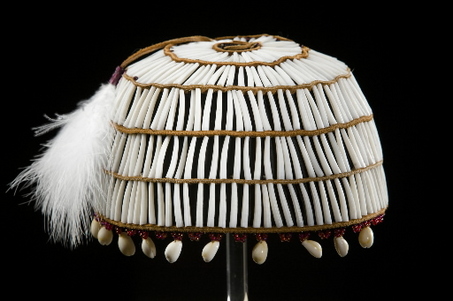Perry Olson, Sue. Dentalium Cap. Dentalia, deer hide, glass beads, cowrie shells. 2002. 4 x 8 inches. Exhibited in The Art of Ceremony: Regalia of Native Oregon, September 28, 2008-January 18, 2009. Salem, Oregon: Hallie Ford Museum of Art, Willamette University.
Photo: Frank Miller
Originally published June, 2009
Historic and Contemporary Ceremonial Regalia of Native Oregon on Tour
By James Bash
“I came to see the handwork, beads, weaving, and design work, in this wonderful exhibit. What beautiful beadwork. Great detail in everything I saw. I loved the fascinating regalia. There”s such a desire to pass on these skills. Thank you for the lessons of these people.”
These are just a few of the comments left by people who experienced The Art of Ceremony: Regalia of Native Oregon exhibition at the Tamastslikt Cultural Institute, which is located in the Confederated Tribes of the Umatilla Indian Reservation. The visitors were impressed by handmade headdresses, drums, necklaces, robes, staffs, and other pieces that help to mark important ceremonial events, such as weddings, memorials, and Longhouse gatherings of Oregon”s tribes.
These ceremonial artifacts — known collectively as regalia — are the centerpiece of The Art of Ceremony exhibition. Each masterwork came from and was selected by Oregon”s nine federally recognized tribal communities. Some of the selections are over 100 years old and others were made in this century. Many are part of family collections and have special significance in ceremonies celebrated today.
“Regalia call attention to the most sacred, honorable, and treasured philosophies, practices, and ethics of our peoples over thousands of years,” explains Bobbie Conner, museum director at the Tamastslikt Cultural Institute. “I am a member of the Confederated Tribes of Umatilla. When I hear the drum roll call of the hand drums of the longhouse, I know that it is a time of ceremony. When I see rocks, and antler handles, root, the medicine, the water for the sweat house, I know that I”m in a sacred space. When I look at the eagle staff that represents us when we parade, I know that the fur, the eagle feathers, and the staff itself represent the people and all else that lives here as we undertake a ceremony.”
Each regalia item reflects the traditions of a tribe, its habitat, and the artistry of the person who made the piece. Modern regalia-makers create new pieces after learning how to prepare materials according to ancient techniques and cultural guidelines from tribal elders.
“The Art of Ceremony exhibit is remarkable,” adds Conner, “because it calls attention to the diversity and variety of peoples, cultures, habitats, and skills represented. It is also something very different than contemporary powwow regalia, which is an amalgamation of regalia styles. What you see in this exhibit is not amalgamated. You can tell the plateau people from the coastal people. You know that each piece is used in ceremony, and there is no commercial value involved.”
The Art of Ceremony exhibition, sponsored in part by a grant from the Oregon Arts Commission, has been shown at the Hallie Ford Museum of Art at Willamette University and at the Tamastslikt Cultural Institute. From June 26 through September 12, it will be on display at The Museum at Warm Springs, which is located in Warm Springs, Oregon.
Courtesy of The Oregon Arts Commission.
Artist Credit: Tamastslikt Cultural Institute, Museum at Warm Springs
Exhibition: The Art of Ceremony: Regalia of Native Oregon, September 28, 2008-January 18, 2009
